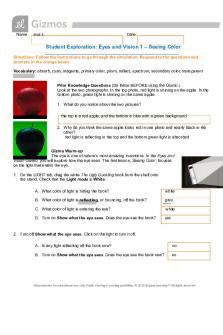Light and Color (Lab #1) PDF

| Title | Light and Color (Lab #1) |
|---|---|
| Course | Chemistry And The Arts-Lecture And Laboratory |
| Institution | Queensborough Community College |
| Pages | 3 |
| File Size | 84.5 KB |
| File Type | |
| Total Downloads | 21 |
| Total Views | 162 |
Summary
lab report...
Description
Light and Color September 12th, 2017
Objective: The goal for this experiment is to learn how light and color intertwine with one another and how it is measured. Introduction/Theory: Our knowledge of light and color began with the series of experiments performed by Isaac Newton in which he published in 1672. The color of light depends on its wavelength which is measured by an electromagnetic spectrum. The electromagnetic spectrum is just another way to say rainbow in a more scientific way; known as “Roy G. Biv” (Red, Orange, Yellow, Green, Blue, Indigo and Violet). The wavelengths of visible light ranges from 700 nm at the red end of the spectrum to 400 nm at the violet end. “Nm” stands for nanometer. It is the unit of measurement used when measuring wavelengths of light. The higher the nanometer the bigger the wavelength is. However, the frequency/energy gets lower. There are three primary colors of light which are green, blue and red. When those colors are mixed with opposite mediums, they create other colors such as yellow, cyan and magenta which are primary colors of pigments. However, when they reflect one another, it appears as white. Lastly, the color black appears when white absorbs a color. Materials: -Flashlight -2 Prisms -Three Flashlights (green, red, blue) -Color Paddles -Spectrophotometer
-Cuvette -Solvent -Dye/Ink (yellow, magenta, cyan) -Test tube Procedure/Observations: For part one of the experiment when the white light was aimed at an angle towards the prism, the prism reflected off the colors of the rainbow which is known of as “ROY G. BIV” (Red, Orange, Yellow, Green, Blue, Indigo and Violet). For part two of this experiment, when the colored light overlapped one another, it looked as if the colors were mixed together to create a new color. For example, when the green and red light overlapped one another the outcome was yellow, green light overlapped blue light produced cyan, red light overlapped blue light produced a magenta light and lastly when all of the lights overlapped one another (green, blue and red), they created what is known as white light. For the next part of this part of the experiment, when the red object was put in front of the green light, a black shadow/light was produced. A spectrometer was used in order to complete part three of this experiment. A cuvette was filled with the solvent in order to be placed inside of the spectrometer. The cuvette was filled with different dyes then mixed with different dyes according to the instructions. For this part of the experiment you were able to learn what the colors absorbed and reflected. For example, yellow absorbed blue and reflected both green and red, while magenta absorbed green and reflected blue and red, and cyan absorbs red while reflecting blue and green. When the colors are mixed, they absorb one another's absorption regions. For example, yellow and magenta mixed together absorbed both blue and green reflecting red, while yellow and cyan mixed together absorbed both blue and red and reflected green, and lastly cyan with magenta absorbed red and green while reflecting blue. Just like primary colors of light (green, red and blue), when primary
colors of pigments (yellow, magenta and cyan) are overlapped.mixed with one another, different colors are produced. When yellow and magenta overlap one another, green is formed, while red is formed when yellow and cyan overlap one another. Blue is formed when magenta and cyan is overlapping each other. Lastly, the color black is formed when all three of the primary pigment colors overlap one another. Conclusions and Sources of Error: The experimental objectives for this experiment were met because the directions were followed consistently throughout. Each part of the experiment corresponded to the to the outcome of the pictures in the lab manual. I’ve learned that when primary colors of light are mixed with one another they create the primary colors of pigments and vice-versa. I also learned that black is created when white is absorbed within the colors and whites is created when it is reflected....
Similar Free PDFs

Light and Color (Lab #1)
- 3 Pages

Color 1
- 1 Pages

PHET color my world lab - Lab
- 4 Pages

Science 1-Light Sound and Force
- 1 Pages

SA 1 True color
- 3 Pages

Color
- 13 Pages

Light Waves and Matter Worksheet
- 2 Pages

heavy khey and light key
- 2 Pages

Speed Of Light Lab Write Up
- 8 Pages
Popular Institutions
- Tinajero National High School - Annex
- Politeknik Caltex Riau
- Yokohama City University
- SGT University
- University of Al-Qadisiyah
- Divine Word College of Vigan
- Techniek College Rotterdam
- Universidade de Santiago
- Universiti Teknologi MARA Cawangan Johor Kampus Pasir Gudang
- Poltekkes Kemenkes Yogyakarta
- Baguio City National High School
- Colegio san marcos
- preparatoria uno
- Centro de Bachillerato Tecnológico Industrial y de Servicios No. 107
- Dalian Maritime University
- Quang Trung Secondary School
- Colegio Tecnológico en Informática
- Corporación Regional de Educación Superior
- Grupo CEDVA
- Dar Al Uloom University
- Centro de Estudios Preuniversitarios de la Universidad Nacional de Ingeniería
- 上智大学
- Aakash International School, Nuna Majara
- San Felipe Neri Catholic School
- Kang Chiao International School - New Taipei City
- Misamis Occidental National High School
- Institución Educativa Escuela Normal Juan Ladrilleros
- Kolehiyo ng Pantukan
- Batanes State College
- Instituto Continental
- Sekolah Menengah Kejuruan Kesehatan Kaltara (Tarakan)
- Colegio de La Inmaculada Concepcion - Cebu






